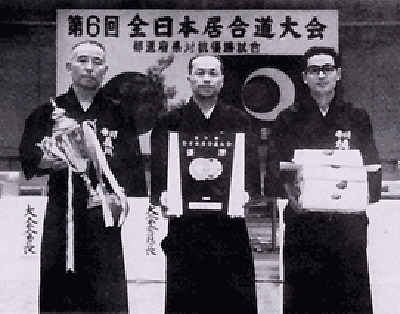 |
Another important point in Nukitsuke is posture. Many people misunderstand
the meaning of Seme (attack). It does not
mean violent action. Fighting spirit and violence are entirely different
things. An overactive fighting spirit can create violence. In Nukitsuke
the body unnecessarily leans forward. There are other things that should
be mentioned;
a, In a bent over posture it is impossible to maintain Ki and power in the Tanden.
b, If the upper body is bent forward the balance of ones weight will incline
forwards during action. As a result of this there is not enough weight left
on the back leg or foot, so the knee will slip backward during action.
c, In a bent over posture one also loses power against the opponent as ones
stature is lowered.
Iwata Sensei winning the 6th All Japan Iaido
Championships |
d, It is difficult to finish in a correct posture if one starts out in a bad
one. An upright body and power in the Tanden would
be effective advice given by the old masters.
BRINGING BOTH KNEES TOGETHER.
In the Seiza section of our Ryu, Batto (Nukitsuke), Hiza-awase (Note 1) and
the action of raising the hips must be done simultaneously.
a, Hiza-awase is the preparation to move forward to take Nukitsuke action.
The toes of both feet and knees initiating the action. It is a very important
to concentrate ones body weight on a single point whilst moving the body forward
powerfully with speed. This is why we must bring the knees together before Nukitsuke.
After Hiza-awase raise the hips to get ready to go forward. At this moment the
body is on a single straight line, because the right foot is almost off the
ground in preparation to go forward and the full body weight is on the left
knee and toes. This body posture should be extremely flexible to counter against
any situation.
b, Hiza-awase is also a defensive posture. In times when Judo was called Yawara,
one hand covered the groin for protective reasons. In Iaido, Hiza- awase seems
to have the same purpose, offering protection against a groin kick (Kin-geri).
however this is not the major purpose of Hiza-awase.
NUKITSUKE LOGIC - BATTO AND HIZATATE
Kneeling on both knees with the toes touching the ground. In this connection
there are two methods of rising.
1. Rise up onto the toes before starting Nukitsuke or. . . . .
2. Start Nukitsuke before the toes are raised.
The first one is used if there is plenty of time to
draw the sword or the ground conditions are rough and it is difficult
to instantly draw the sword. Also another purpose is to prepare the lower half
of the body for action.
Nowadays in doing Iaido, the floor condition is quite smooth and even. Therefore
in most cases the first of these methods is used. There are many other reasons
for doing this. In any case the power and pressure against the opponent is the
actual Nukitsuke. I personally prefer the second method for my own practice
as this way I do not have to worry knees, feet or the floor condition.
THE RELATIONSHIP BETWEEN BATTO AND THE ANGLE
OF THE BLADE.
It is advisable to start Nukitsuke while the edge is still upward. This is
practically impossible to do because within action the blade is moving from
left to right to cut a target horizontally. No matter how ones grips the Tsuka,
the up-pointing edge must be turned outward to take Nukitsuke action. The effectiveness
is in the timing. At what stage the edge is turned outward to take Nukitsuke
(Note 2).
 Start preparation for Nukitsuke
by; Turning the sword outward before drawing the sword.
Start preparation for Nukitsuke
by; Turning the sword outward before drawing the sword.
 Turn the sword outward according
to the blade movement.
Turn the sword outward according
to the blade movement.
 Keep the edge pointing upward
until the last split second before dispatching the blade.
Keep the edge pointing upward
until the last split second before dispatching the blade.
If the conditions allow I would recommend the last point.
In the 1950 s whilst training in Kochi City, some of my friends used to drop
the right shoulder to draw the sword. In dropping the right shoulder drastically
it enables one to grip the Tsuka whilst keeping the edge upward. Although I
did not approve of this action it was understandable.
The angle of the edge and right hand control.
How and to what degree one should turn the edge is a very important point,
as it is the right hand control which creates different results. Turning the
sword outward with the left hand before drawing the blade is not so difficult.
However taking action with the blade inclined outward is indeed a difficult
task. Wrist control and flexibility of the right hand and combination of both
hands etc. is extremely intricate but is most essential element. Unbalanced
control of the hands creates a great difference in the result. Nevertheless
if practice comes first good results will follow automatically.
Note1: Hiza means the knees. Awaseru; The Japanese
verb to put or join things together, unite, combine, connect, amalgamate etc.
Note 2: Iwata Hanshi teaches that the power
of the cut is derived from this twisting action. If there is no power in the
twist, one cannot cut.
 |
Page 6 |
